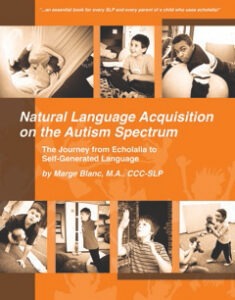Supports: Stage 2
Stage 2 is exciting! It’s when GLPs are often recognized as talking for the first time! This is because:
- Their mitigations are shorter than their former gestalts
- Shorter utterances are easier to say
- This makes them easier for others to understand
- Mitigations are useful, and used, in more situations
So supports at Stage 2 are usually fun and rewarding — for everyone. Often so much fun, and so rewarding, that GLPs sometimes just want to stay there. This is good, because they learn all about communication at Stage 2. The more success they achieve now, the more they will be prepared for further success.
The principles for Stage 1 still apply. We should avoid questions, and make statements instead — and model from a first person perspective (“I”), our joint perspective (“We” or “Let’s”), or a neutral perspective (“It”). Gestalt kids repeat gestalts, so we don’t want to create ‘pronoun reversal.’
Most of all, don’t rush it! Our kids lead us to Stage 3 when they are ready! We can support them best by enjoying Stage 2 along with them.
Supports at Stage 2 include these:
1. Provide lots of ‘redundancy’ in your language modeling. Instead of just modeling something one way, start thinking about modeling a pattern a couple ways, in a couple different situations…then several ways in several different situations. Use natural intonation that shows you care about what you’re saying. You can be animated or musical if your child prefers that.
- I’m + trying to find you!’
- ‘I’m + getting tired!’
- ‘I’m + catching up with you!’
- ‘I’m + gonna get you!’
As kids get good at using mitigations, you will grow with them by providing even more variety, using the patterns you learned about at Stage 1. You can turn almost any sentence into a good language model once you get used to it. And you can avoid ‘you’ and ‘your’ at the same time! So instead of saying, ‘Do you want to go to the store?’ or ‘Wanna go outside?’ or ‘I’ll help you find your shoes’ or ‘We should go a little faster’ you can say:
- ‘Let’s go + to the store!’
- ‘Let’s go + outside!’
- ‘Let’s go + find those shoes!’
- ‘Let’s go + faster!’
2. You can also support your child by acknowledging the mitigations you hear, acknowledging them back to your child in a conversational and fun way — but clearly, so they ‘know that you know,’ and can hear how to say them, so they have a clear model for the next time. This helps others understand them also!
3. Language sampling is very important at Stage 2:
- When you hear, “It’s + xx’ with different endings, you can train yourself to recognize it in other situations — and think about how you can model it in even more kinds of situations: not just naming things, but expressing feelings (“It’s + so exciting”) and commenting (“It’s + Saturday!” “It’s + blue and gold!”)
- But when you hear “I gotta + go to bed,’ and you never say “I gotta + …” anywhere else, you know it’s not yet a mitigation.
- This rule applies to everything at Stage 2. If you hear the single version of the gestalt only, that’s great, but that makes it Stage 1. You need to hear its mitigated version also to make it Stage 2. This is ‘mix-and-match,’ and it will eventually happen for many, many gestalts! These shorter utterances/mitigations can be used in many situations — to communicate many different intentions/functions. Talk to your SLP/SLT and read more about NLA scoring for further clarification
- Share new utterances with others. Make a book or list so others will recognize these newly-minted mitigations. The more our GLPs are understood, the more confidence they will gain in communicating.
- You can also support your child at Stage 2 by taking notes, keeping a journal, and checking in with your SLP as you inventory your child’s growing repertoire of mitigations
4. Remember that some mitigations are simply shorter versions of long Stage 1 gestalts. This makes them easier for the child to access in their heads, and to say — and makes them so much easier to understand!
- You can support your child best in this endeavor by listening for the ‘fast forwarding’ kids often do in order to skip over the parts of gestalts they don’t want to say. This is mitigation-in-action (real time) and is common in older kids who have long movie gestalts, sometimes even whole episodes or whole stories! Shorter mitigations are so much more useful!
- Listen for the louder parts of long gestalts, because they may be what the child is trying to isolate/mitigate. Please read Bevin’s story in the NLA book for much more information!
5. Once your child has achieved 50% of their utterances at Stage 2, and they serve all the communicative functions we have outlined earlier, your child may be ready to take the next step. It’s up to the child to take that step when they are ready. It’s not up to us at all. So you can rest in that assurance that your child will lead you when they are ready.
But when your child is ready, move forward with them.
Read on to find out how!
